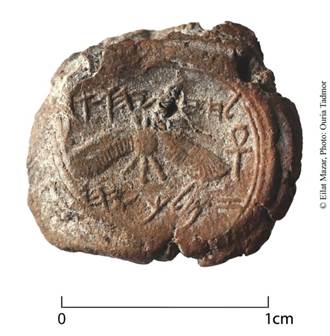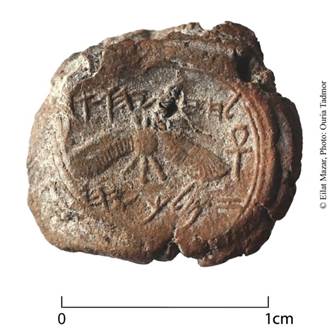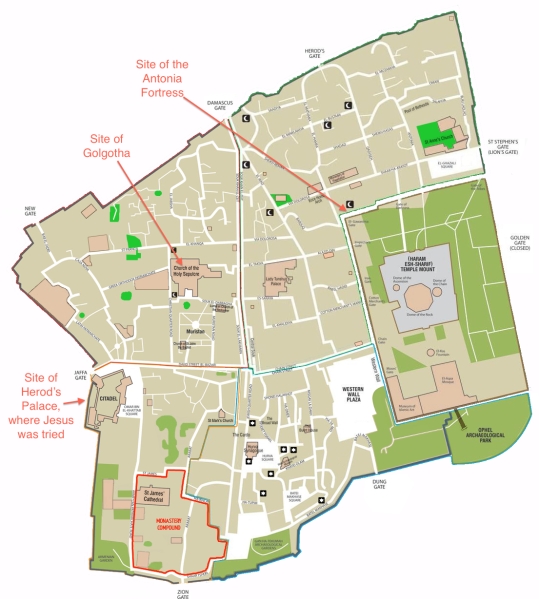Back in 2014, news broke that archaeologists digging near the Jerusalem–Tel Aviv Highway had uncovered a cache of ancient Jewish coins. The inscription and images on the 114 bronze coins allow us to date them precisely to AD 70—the exact year that the Romans conquered Jerusalem and destroyed the temple. In the midst of this turbulent time, a Jewish person saw fit to place the money in a small ceramic box and bury it for safekeeping.
“Evidently someone here feared the end was approaching and hid his property, perhaps in the hope of collecting it later when calm was restored to the region,” said one of the archaeologists involved in the excavations.
Readers of the Gospels will no doubt recall Jesus’ Parable of the Talents (Matt 25:14–30), in which a similar action occurs. In this context, a “talent” was a very large sum of money (not a special ability). The parable goes like this:
“For it is just like a man going on a journey. He called his own slaves and turned over his possessions to them. To one he gave five talents; to another, two; and to another, one—to each according to his own ability. Then he went on a journey. Immediately the man who had received five talents went, put them to work, and earned five more. In the same way the man with two earned two more. But the man who had received one talent went off, dug a hole in the ground, and hid his master’s money.
“After a long time the master of those slaves came and settled accounts with them. The man who had received five talents approached, presented five more talents, and said, ‘Master, you gave me five talents. Look, I’ve earned five more talents.’
“His master said to him, ‘Well done, good and faithful slave! You were faithful over a few things; I will put you in charge of many things. Share your master’s joy!’
“Then the man with two talents also approached. He said, ‘Master, you gave me two talents. Look, I’ve earned two more talents.’
“His master said to him, ‘Well done, good and faithful slave! You were faithful over a few things; I will put you in charge of many things. Share your master’s joy!’
“Then the man who had received one talent also approached and said, ‘Master, I know you. You’re a difficult man, reaping where you haven’t sown and gathering where you haven’t scattered seed. So I was afraid and went off and hid your talent in the ground. Look, you have what is yours.’
“But his master replied to him, ‘You evil, lazy slave! If you knew that I reap where I haven’t sown and gather where I haven’t scattered, then you should have deposited my money with the bankers. And when I returned I would have received my money back with interest.
“‘So take the talent from him and give it to the one who has 10 talents. For to everyone who has, more will be given, and he will have more than enough. But from the one who does not have, even what he has will be taken away from him. And throw this good-for-nothing slave into the outer darkness. In that place there will be weeping and gnashing of teeth.’” (HCSB)
The third slave in the parable does basically the same thing the owner of these newly discovered bronze coins did: bury them in the ground. Evidently it must have been a reasonably common thing to do. What’s interesting, though, is that the owner of the bronze coins buried them in the context of war. He or she was living at a time when the Jewish nation was collapsing under the onslaught of Rome’s forces. Judea was falling! In the hope of surviving the calamity, the owner buried the coins in order to come back to them at a later time.
This action helps us understand Jesus’ Parable of the Talents a little better. The dynamic at work in the parable is not merely economic investment, but rather measures taken during a time of war. Let’s unpack this.
To begin with, let’s notice the context. The parable comes near the tense culmination of Jesus’ ministry in Matthew’s Gospel. On arriving in Jerusalem, Jesus clears the moneychangers out of the temple (Matt 21:12–13). He tells the Parable of the Wicked Tenants (Matt 21:33–46), in which he takes aim at the Jewish leaders, who also happened to be wealthy landowners. Jesus uses the way they would no doubt have treated recalcitrant tenants on their lands to describe what God would do to them because they were rejecting Jesus and plotting to kill him. Jesus also puts the leaders in their place when they try to trap him with the question of paying taxes to Caesar (Matt 22:15–22). In Roman-occupied Judea, the question of paying Roman taxes was an incendiary issue. But using a coin with Caesar’s image on it, Jesus beats the leadership at their own game. There are economic themes running throughout these incidents, and in all cases they point to the villainy of the nation’s leaders. They were sealing the fate of the nation.
Finally, Jesus launches a verbal attack on the leaders before he laments over the future of Jerusalem (Matt 23). Jesus unpacks this in Matthew 24, explaining that not one stone of the temple would remain upon another (Matt 24:2). The nation was heading for downfall under the current corrupt leadership, and the people would find themselves in dire circumstances.
The Parable of the Talents then comes after the Parable of the Ten Virgins (Matt 25:1–13). Both parables have the theme of acting now in preparation for what’s to come. And what is to come? The nation’s downfall.
It is not all dire news, however. Throughout the Gospel, Jesus has been gathering a new people of God around himself—a remnant whose faith in him will enable them to survive as the people of God beyond the downfall of the nation. These are people who repent in the face of the coming Kingdom of God (Matt 4:17). They listen to Jesus’ words and, as it were, build their house on a rock, rather than on sand (Matt 7:24–27). When the future storm comes to pound the nation, theirs is the house that will survive. The storm was the catastrophe of AD 70, in which the nation fell and its “house” (the temple) was left desolate (Matt 23:38).
In the Parable of the Talents, we are not told the reason why the master departs and leaves his property in the keeping of his slaves. If we removed the parable from its context, we might suppose he went on a business trip. But the whole surrounding context is one of doom. It is more in keeping with the tense atmosphere of this end of the Gospel if the master were actually heading away on affairs of state or a military endeavour. Notice that as soon as Jesus finishes the parable, he discusses the Son of Man coming in all his glory to judge the nations (Matt 25:31–32). There is a clear parallel here: just as the master comes to settle affairs with his slaves, so the Son of Man comes to judge the nations. In both cases, the master figure returns in triumph. By implication, his absence is a time of tension and uncertainty.
This helps explain the actions of the third slave in the Parable of the Talents. He buries the money allotted to him because this is what many did in a time of war. This is just what the ancient owner of the bronze coins discovered under the highway in Israel did as Jerusalem was falling to the Romans in AD 70—the very event Jesus had in mind.
The slave’s actions in the parable, however, are not just lazy, but also evil (Matt 25:26). Why? Because he evidently didn’t think his master would succeed in his endeavours and return. If he had thought so, he would have put the money allocated to him to good use for the sake of his master. The other two slaves in the parable evidently had confidence in their master’s return—enough to risk the danger of flaunting money in wartime.
Civilians in the ancient world often hid their resources to prevent harassment and pillage by soldiers. That these two slaves not only put the money to good use, but even made a return suggests not merely their economic savvy, but also their bravery and loyalty in the face of adverse circumstances.
The third slave, however, does no such thing. By burying the money, he tries to keep out of danger in the hope of riding out the current adversity, surviving his master, and then taking the money for himself. The master’s unexpected return, however, puts paid (excuse the pun!) to this servants plans, exposing him as a faithless coward. The master is not angry with this slave because he expected more money from the slave to feed his own greed. He is angry because the slave had been disloyal, lacking faith in his master and seeking to take advantage of his absence for personal gain.
In the larger context of the Gospel, this parable is an indictment on the Jewish leaders—those to whom much was given. They are characterised as disloyal towards God. They had turned the temple, a house of prayer, into a bandit’s lair (Matt 21:12–13), making money off the common person and turning worship into a weapon of oppression. They failed to show the fruit that was expected of them (Matt 21:18–22). They rejected Jesus, the master figure, in order to feather their own nests. This would, however, be a profitless endeavour, for it would end with their demise. Only those who placed their confidence in Jesus would survive the coming adversity and live to share their master’s joy.
We have no way of knowing whether the person who buried the money found under the highway in Israel was a master or a slave. Nonetheless, the cache of coins demonstrates the currency (excuse the pun again!) of the imagery Jesus used to decry the leadership of his day and foretell the calamitous events of AD 70—the very events that led the person to bury that money in the hope of returning some day to collect it.
Unfortunately, that person never returned.

This is an updated version of a post I wrote for another blog soon after the coin discovery was announced in 2014. The photo above appeared with the original news article.


 I really enjoy the “rock opera” Jesus Christ Superstar by Andrew Lloyd Webber and Tim Rice.¹ Despite its somewhat apocryphal take on the events leading up to Jesus’ death, one of the things it tries to do is explore the reasons why Jesus, about whom there was so much excitement, ended up dead on a Roman cross. In the climactic title song, Judas asks of Jesus,
I really enjoy the “rock opera” Jesus Christ Superstar by Andrew Lloyd Webber and Tim Rice.¹ Despite its somewhat apocryphal take on the events leading up to Jesus’ death, one of the things it tries to do is explore the reasons why Jesus, about whom there was so much excitement, ended up dead on a Roman cross. In the climactic title song, Judas asks of Jesus,























